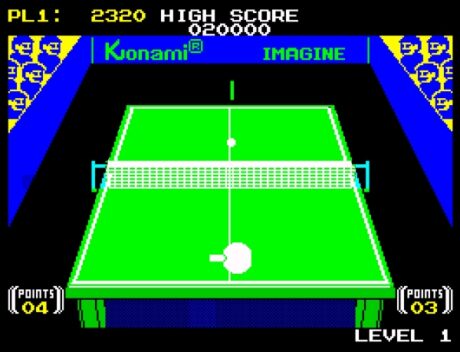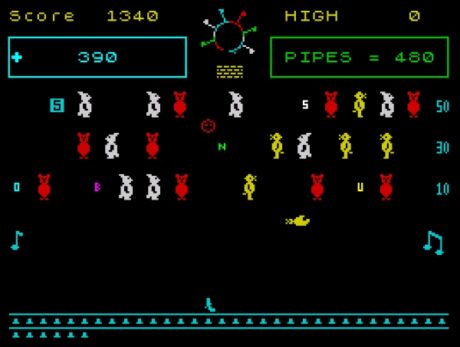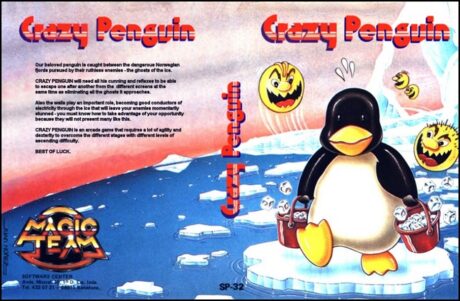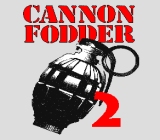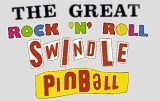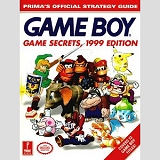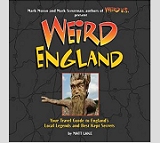The Speccy Arcade 100 (Part 4)
Part 1 (100-81), Part 2 (80-61), Part 3 (60-41), Part 4 (below, 40-21), Part 5 (20-1)
40. PING PONG
Arcade: 1985, Konami
Spectrum: 1986, Imagine
This one was quite hard to place. It’s almost certainly the slimmest game in this entire chart, offering just five stages of perhaps the simplest sport in existence without even the superficial novelty of different opponents.
On the other hand, if you’re going to execute something as exquisitely as this, how much does that matter?
After all, this is a coin-op conversion. Anyone who buys it presumably knows exactly what they’re getting, or at least what they WANT to get – an accurate recreation of the arcade game. And there can be little argument that Ping Pong delivers on that count. It looks as close to a 1:1 clone as is within the Speccy’s power, although I’m not quite sure why they decided to make the table green and black rather than green and white – I can’t really see how it could have caused anything but very minimal colour clash.
And if anything the one-button gameplay is a welcome simplification of the arcade’s confusing and unnecessary two buttons, where normal shots are taken with the joystick but smashes are counter-intuitively on the second button and it takes much longer to get your head around for no gameplay gain.
Every point on the Speccy version is a delightful joust of thrust and parry, with quick thinking and hand-eye co-ordination increasingly crucial as the game takes you along a well-judged difficulty curve. (It’s a little bit slower than the arcade, but that just tips the balance slightly more towards the tactical than pure reactions.)
Konami’s central innovation – doing away with all the boring running around after the ball, leaving you to concentrate only on shot selection – is revealed as a stroke of genius, turning every point into a “How did I mess that up?” facepalm instead of a curse at an infallible superhuman opponent whacking the ball into an unreachable corner.
But at the end of the day, it IS still inescapably shallow and limiting (as befits its arcade heritage). There’s none of the madness of real ping-pong, with players racing around an arena the size of a REAL tennis court pulling off absurd 20-foot shots. And ironically it does such a good job of teaching you that you’ll best it all too soon, with very little incentive to come back once you’ve got the beating of Level 5 other than the occasional 10-minute zip through the whole game just for the pleasure of it.
Ping Pong is a beautiful thing, superbly ported, and on its own terms it’s basically flawless, but it just runs out of steam too quickly to climb any higher than this.
—
MYSTERY MENTION: The game was released in arcades as Konami’s Ping Pong, although the Speccy version is just plain Ping Pong. Imagine also released a game called Konami’s Tennis the same year, along with Konami’s Golf, but I can find no record anywhere of Konami ever releasing arcade games under those names (or any other Konami tennis or golf games that they could be ports of). So that’s a bit weird.
——————————————————
39. CHASE HQ (128K)
Arcade: 1988, Taito
Spectrum: 1989, Ocean
You’re shocked, I know. This game was voted the Speccy’s best of all time by readers of Your Sinclair, although they also put Mr Freeze at No.90 so let’s keep their opinions in some sort of perspective.
And if this was just a chart of technical achievements, Chase HQ would be a lot nearer the top. For a start, it’s surely the best-looking 3D racer the Speccy ever produced, and it’s not even a very close contest. It’s also both fast and smooth, with lovely animation.
But the problem in the end is that while as stunning a feat of programming as this is, it’s still a port of Chase HQ, and Chase HQ just ain’t all that great. While the racing bit is terrific, zooming along through towns and over dirt tracks and through tunnels and whatever, the ramming phase is dull and fiddly and drags on far too long (which is why they gave you a gun in the sequel).
None of that is the exemplary port’s fault, but I’m sure we’ve all dreamed of what could have been if Chase HQ’s coders had been given the Out Run job instead.
—
HONOURABLE MENTION: Out Run LOL JOKING. But the sequel, Turbo Out Run, is a halfway-decent effort even if your giant Ferrari obscures half of the road in front of you.
And we should also take this chance to award a moderate amount of kudos to Continental Circus, which is a fast and smooth racer that’s not half bad at all but not quite strong enough to get into the chart on its own merit, thanks to some unsophisticated steering, very samey graphics and the quite distracting way the engine noise stops whenever you overtake someone.
——————————————————
38. QUACKSHOT (Tutankham)
Arcade: 1982, Konami
Spectrum: 1985, Sparklers
Tutankham was a ridiculously hard arcade game whose atmosphere did most of the heavy lifting. Endlessly-spawning baddies flooding into passageways where you can only shoot horizontally made it a bit of a grind, perhaps to conceal the fact that it only actually has four levels, which repeat endlessly if you clear them.
The Speccy’s first attempt at a clone, Micromania’s primitive-looking but slick Tutankhamun, improved significantly on that with 14 different tombs to explore, although your hero’s jittery movement suggested a serious case of claustrophobia-induced anxiety.
Tutankhamun got the job done well enough for a couple of years until budget label Sparklers produced Quackshot, which was not only far superior visually but has 16 stages, the first two of which are accurate replications of the coin-op’s mazes before it goes off and does its own thing, which includes some quite inventive level designs.
There isn’t really much else to say about it. If you liked Tutankham, Quackshot was in most key respects identical but there was four times as much of it. That’s a result in anyone’s book.
—
HONOURABLE MENTION: Cavelon is a surprisingly similar game in nature, and Ocean’s copy of it both simplifies and slightly improves on the coin-op. It only narrowly failed to make the chart.
——————————————————
37. DONKEY KONG ARCADE EDITION
Arcade: 1981, Nintendo
Spectrum: 1986, Ocean/2019, Pgyuri & Mick Farrow
The Spectrum had perhaps more absolutely terrible attempts at clones of Nintendo’s iconic Donkey Kong than of any other game.
They included what’s widely regarded as the machine’s worst game of all time, C-Tech’s hilariously bad Krazy Kong. The various efforts were so dire that for several years Ocean’s deeply dreadful unofficial version, simply entitled Kong, was probably the best of a truly abysmal bunch.
So when the publisher cleaned up its act in 1986 with a legitimate licenced conversion, it had a very low bar to clear. Its phenomenally good Amstrad CPC port, sadly, wouldn’t be replicated on the Spectrum, but we did get a sort-of okay version with all four stages included (which remarkably gave it a big advantage over almost all the official conversions up to that time, including the NES one), and also unusually appearing in the proper Japanese/European order.
For completely unfathomable reasons, though, Sentient Software decided to recolour the whole game so that it looked nothing like the coin-op. The first and third stages got weird pink girders and white ladders instead of the proper red and cyan, and the fourth stage was an inexplicable atrocity in green and red instead of blue and yellow.
So when I talked Pgyuri into deploying his magic paintbrush to fix it in the Donkey Kong: True Colours Edition, we already had a game that looked and felt much more like arcade Donkey Kong.
But the improvements weren’t over. Sentient had given the game a nondescript “Jumpman” that looked like some random flat-capped chubster in a one-piece jumpsuit, but the supertalented Mick Farrow stepped in to complete the reworking with an almost perfect dungareed Mario and a whole new set of graphics to go with him, from girders to barrels and fireballs and a much less deformed-looking Kong.
In truth the gameplay (mainly the jumping) still leaves a little bit to be desired and a truly definitive Speccy DK to compete with the Amstrad version is still a dream, but the cosmetic transformation alone is so dramatic that when it comes to feeling like the coin-op the Arcade Edition is in a different league to Ocean’s release, which itself was in a different league to the previous attempts, and our little black wonder can finally hold its head up at meetings of the Kong Konversion Klub (an organisation whose name has led to some unfortunate but hilarious misunderstandings).
—
HONOURABLE MENTIONS: None. Other than this, the history of Donkey Kong on the Spectrum is all dishonour.
——————————————————
35. SPECTIPEDE (Centipede)
Arcade: 1980, Atari
Spectrum: 1983, R&R
As with Battlezone a few entries ago, there isn’t a huge amount of explanation required for a game like Spectipede.
The Speccy had bazillions of ports of Atari’s bug-blasting classic – DK’Tronics had two different goes at it by themselves – but the bulk of them are pretty bad, missing out one or more key features. Loads of them, remarkably, don’t even have diagonal movement.
Spectipede does, though, and boasts the full roster of arcade beasties all behaving just like they do in the coin-op. (Including the centipede behaving properly in the bottom section of the screen, which lots of clones failed at.) The only inaccuracy I’ve noticed is that it clears the poison mushrooms for you after every screen, which is a useful assist in a fast and challenging game that looks good and has pleasingly zappy sound.
Despite a couple of titles borrowing the name, nobody appears to have tried to actually port the more interesting arcade sequel Millipede to the Speccy, so Spectipede is the best way to commit mass insecticide the old machine has to offer, and a terrific pure arcade shooter in its own right.
—
HONOURABLE MENTIONS: Thor’s weirdly-named Night Stalker is the best of the rest. It messes up the centipede movement in the player area (when it reaches the bottom row it just teleports back to the top), but it’s otherwise solid and scores a point over Spectipede by offering 10 difficulty levels for those of you with no motor skills.
MYSTERY MENTION: Centipedes by EMM Software and Rapedes by Visions appear to be slightly modified versions of the same game, although they’re credited to different people.
The EMM version, credited to Boris “G-Force/Tempest” Baginski, has batshit-mad 11-key controls (10 for movement and a fire button) with no joystick option and no sound, but 10 difficulty levels.
The Visions version has good sound and sensible controls, but only five speed settings (only one of which is worthwhile), no diagonal movement and incredibly no autofire, rendering it all but unplayable. The two versions combined into one could have been excellent, but instead we got two messes.
——————————————————
35. ROLLING THUNDER
Arcade: 1986, Namco
Spectrum: 1988, US Gold
There’s a unique elegance to arcade Rolling Thunder. Maybe it’s your tall, slim, ramrod-backed hero in his smart polo-neck-and-chinos combo, or maybe the authentic spy-serial music, or the classy palette in primary colours against the sober battleship grays of the evil villain’s underground lair, but it’s a notably handsome game that doesn’t really look like anything else.
Now, there’s a lot of that the Speccy can’t replicate, but the clean-cut conversion (by John Prince, author of the classic “overhead Deathchase” shooter Storm Fighters, Stuey’s obscure favourite games fans) manages to look pretty sharp by itself.
The characters and animation are instantly recognisable, and the use of colour is really clever, particularly the choices of the Speccy’s dark and bright shades in some areas to make background and foreground stand out from each other.
Some levels are simplified somewhat, but most of the game is in there, and it plays all but identically to its parent. (Right down to recreating videogaming’s dumbest ever energy bar – eight units that can only ever read 8, 4 or 0.) It places above the very similar Shinobi because clarity beats prettiness, and because it has significantly better controls for performing the same tasks.
It’s also a game crying out for a modern 128K mod with AY music, but for now we’ll just have to appreciate it for what it is.
——————————————————
34. WEST BANK (Bank Panic)
Arcade: 1984, Sega
Spectrum: 1985, Dinamic
I assume West Bank must be set in Australia, but we’ll get to that in a minute. Bank Panic is a charismatic and instantly appealing coin-op that looks like it should be a light-gun game but isn’t.
Setting you up as security guard in a weirdly circular bank with WAY too many doors, your job is to make snap decisions every time one of them opens, about whether the person standing behind it is a customer trying to make a deposit or a bandit planning an illegitimate withdrawal that can only be stopped by a bullet between the eyes.
Both of the Speccy’s clones originated in Spain, but West Bank got a UK release after being bought up by Gremlin Graphics. It’s a really nice-looking clone with gorgeous graphics, although as well as missing the classic “Look Away Dixieland” music the arcade gameplay’s been dumbed down quite a bit, with fewer possible scenarios behind each door.
That’s a pity, because what’s there is beautifully executed and does a very good job of recreating the Bank Panic experience, and with just a bit more effort it could have been reaching for our top 20. But one thing about it jars like a bank door that’s not a door. (Because it’s ajar. Keep up.)
When you’ve ratched up some deposits at the three windows you’re defending at any one time and want to move on, you press left or right and the doors of the bank scroll in WHAT IS QUITE OBVIOUSLY THE COMPLETELY WRONG DIRECTION.
It’s really disorientating, and I can only assume that the coders wrote the game while on holiday in the Southern Hemisphere where water goes down the plug the wrong way round and everyone is upside down, but forgot to adjust for where it would be sold. I’m afraid that’s a mandatory five-place penalty, lads.
—
HONOURABLE MENTION: Silvergun aka The Bang Bank appears to have been a remarkably high-quality covertape-exclusive version of Bank Panic from the Spanish magazine Micro Hobby.
It’s very like the Gremlin game, with more colourful (but less clear) graphics and basically identical gameplay, except it seems that banks in the Spanish Wild West had almost entirely robber clientele. At least the doors scroll the right way, though.
——————————————————
33. CARNIVAL (fixed edition)
Arcade: 1980, Sega
Spectrum: 1984, Eclipse (fixed 2020 by Pgyuri)
Eclipse’s extremely faithful rendition of Sega’s fairground shooter was fatally flawed by a bug that no reviewer noticed at the time, and which rendered the game impossible after stage 2.
Which was a terrible shame, because just look how close to the coin-op it was.
But lo! Thanks to the tireless history-fixer that is Who Else But Pgyuri, for the last year Speccy owners have been able to enjoy the phenomenal conversion of a highly likeable but challenging arcade game that Carnival so nearly was in 1984 and now finally is just 37 years later. Now if only someone could do something about the music.
—
HONOURABLE MENTION: Actually someone did. Kobrahsoft’s 1987 release Sharpshooter is so little-known there isn’t a single video of it on YouTube and it didn’t get a single review in a magazine.
But it’s still a really decent port of Carnival, not far behind the Eclipse version, and uses the authentic arcade calliope music. It isn’t quite as pretty as Eclipse’s version but it sounds better and plays pretty much the same, so you pays your money and you makes your choice.
——————————————————
32. CRAZY PENGUIN (Pengo)
Arcade: 1982, Sega
Spectrum: 1986, Magic Team
Pengo is surely one of the most-ported and most-cloned videogames in history. My own personal Retropie collection of Pengos has almost 60 different games in it, and that’s just including the good and/or interesting ones.
There were also tons of Speccy clones, of which my favourite for many years was Silversoft’s Freez’ Beez (aka Frozen Penguin), which despite an iffy colourscheme and lacking the major gameplay feature of the diamond blocks was a really zippy and authentically tough port.
It wasn’t until I was putting together the Retropie collection that I found some of the others, which all have their pros and cons, but by far the most complete and accurate recreation of the coin-op is the splendid Spanish effort Crazy Pingoin.
It’s got everything – the diamond blocks, the electric fences that are missing from several versions, more or less the right colours, and even a warbly Speccy rendition of the famous “Popcorn” music of the original arcade release. (Later revisions, including Sega’s own licenced ports on formats like the Game Gear, Mega Drive and Switch, replaced it with new music after copyright issues.)
So unless the Spanish bugs you because you can’t work out that “PUNTOS” means “POINTS”, this is a practically perfect Pengo. And if it does, well, I’ve translated this one (and even the tape box) into English for you too. Click the pic to download.
—
HONOURABLE MENTIONS: Freez’ Beez is definitely the best out of the rest, but Micromania’s Pengy is a fair stab as well, as is Sinclair User’s warehouse-themed covertape effort Go Bear Go.
(While it’s probably the best known, Ocean’s Eskimo Eddie is absolute rubbish – even with the tedious preliminary Froggerish minigame and the long delay for it to play a jingle every time you die hacked out, your penguin is frozen on the spot for several seconds while iceblocks slide across the screen, which is deeply tiresome.)
——————————————————
31. DINGO
Arcade: 1983, ACG
Spectrum: 2011, Tardis Remakes
The tale of Dingo is a beautifully circular one. The arcade game, a sort of cross between Targ and Food Fight in which a teddy bear who looks nothing like a dingo runs around a jungle throwing fruit at bouncing horsey animals who also look nothing at all like dingoes, was one of the early works of Ashby Computer Graphics, later to be known as Ultimate Play The Game.
Seen with hindsight one can spot the roots of Sabre Wulf in it, but it wasn’t a hit, and very few people had ever heard of it until decades later when the existence of MAME gave it a second lease of life and people suddenly noticed the credits.
And it was at that point that Tardis Remakes decided to bring it home to the Speccy.
And what a fine job they did. The port is visually gorgeous and it plays just like its parent – fast and slick and frantic and, well, Ultimatey. What was puzzling was that despite having 128K sound available and being a very simple one-screen game that can’t have taken up a lot of memory, they left out the ingame music.
Why, I have no idea. Maybe it made the game run less smoothly, in which case it was a worthwhile sacrifice. But everything else about the port is so wonderful that it’s a bit of a heartbreaker that the music didn’t make it in, and it feels a little sparse as a result.
It’s not a DEALbreaker – there are loads of games in this chart that lack the arcade music, and Dingo’s music wasn’t that great anyway – but for some reason the omission seems more painful here than most, because this could have been all but indistinguishable from the coin-op. It’s still such an excellent piece of work that it’s made the top 30, though, and seeing a lost Ultimate classic back where it belongs is a “RARE” joy yes yes I’ll get my coat.
—
HONOURABLE MENTION: A game where the missing music WAS a dealbreaker was Majikazo, a fine 2012 port by Retroworks of the obscure Namco block shooter Toypop.
It’s a very good clone, with cute cartoony graphics and pretty much all the gameplay elements, but the problem is that Toypop is a pretty thin game distinguished only by its super-catchy fairground music, and without it Majikazo is a bit of a repetitive trudge lacking Dingo’s addictive intensity.
——————————————————
30. METRO-CROSS (128K edition)
Arcade: 1985, Namco
Spectrum: 1987, US Gold
Metro-Cross was a quirky little low-key release from Namco that isn’t really like any arcade game before or since.
The original Speccy release was a very fine port that nailed the gameplay with great accuracy, boasted nice clear graphics too – it’s a fundamentally monochrome game that doesn’t LOOK monochrome, thanks to judicious use of background colour – zipped along at a fair old pace with a very solid framerate and missed only the music, until it was added by a 2021 mod.
It’s a perky little tune that really livens up the atmosphere, but even without it the standard 48K game, which plays really nicely and fits into a single load even on the humble original machine, would merit a high placing.
It’s just a top-notch port of a fun coin-op with no particularly interesting features or backstory that I know of, so that’s pretty much all I can think of to say about Metro-Cross.
——————————————————
29. PAC-MAN (EMULATED)/PAC-HACK PLUS
Arcade: 1980, Namco
Spectrum: 1984/2011/2019, Atarisoft/others
For years the Speccy lacked anything remotely like a definitive Pac-Man.
And then all of a sudden there was a competition. In one corner, the stunning emulated version:
And in the other corner, instigated by your humble correspondent and executed by Allan “highrise” Turvey, the splendiferous if terribly-named Pac-Hack, a mod of the official Atarisoft release (itself a mod of DJ Looker’s unofficial Z-Man) which squishes the landscape-format maze up to much more arcade-like dimensions.
Each has pros and cons. The emulated game is obviously arcade-perfect in almost every detail. Its downsides are that it runs on the +2A and +3 only, the graphics are exactly the wrong sizes for the Spectrum so there’s a really uncomfortably large amount of colour clash unless you play it in mono, and (oddly) there’s no high score.
Pac-Hack, on the other hand, has crude character movement but is fast and intense, has a pretty bezel surround (in its Plus version) and a high-score table, and plays on even the humblest 16K Speccy. It’s a huge improvement on the Atarisoft version, completely changing the character of what was a playable port but where moments of action were few and far between. Now it’s ALL action, because in the shrunken-down maze the ghosts stay blue for what’s now a relatively long time, so you’re constantly tempted to chase them down for big points rather than just clearing the maze.
Pac-Hack is the one I’ve played the most (mainly due to the colour issues) – indeed, I’ve probably played it more than I have any other port of the game or even the arcade original – but how could you possibly leave something like an actual arcade emulator running at full speed on a 1980s micro-computer out from a best coin-op conversions chart? So they’ll just have to share.
—
HONOURABLE MENTION: Also worth checking out is the mysterious Croatian title Spec-Man, which looks like an unfinished homebrew version but a very accomplished one. Grandslam’s conversion of Pac-Mania is a good effort in almost all respects, but the huge gulf in movement speed between the vertical and the horizontal planes makes it feel like it’s suffering from crippling slowdown every few seconds, and it’s just too constantly distracting to enjoy the game.
——————————————————
27. G-FORCE (Tempest)
Arcade: 1980, Atari
Spectrum: 1983, EMM Software
Tempest’s colour Quadrascan visuals were an almost impossible ask for the poor colour-clashing Speccy, as the skanky official port illustrated. What was needed was a radical thinking-outside-the-box solution, such as the one Alexander The Great adopted to the Gordian Knot.
Boris Baginski’s approach was to forget about about graphical fidelity and instead try to capture the heart of Tempest. So the varied array of pseudo-3D “webs” was replaced by a single flat rectangular surface, but the roster of baddies remained, rendered in (for the Speccy) unusually beefy, chunky graphics which conveniently allowed it to be a blaze of non-clashing colour.
The introductory stages could be skipped (for bonus points, like the arcade) in order to drop you straight in at whatever level of mayhem you could handle, a level of user-friendly professionalism that was very rare for the time. There was also an inventive if impractical attempt to mimic the analogue control of the arcade’s spinner by having fast and slow movement keys, but you can just ignore that in play to no noticeable detriment.
The key is that G-Force is a manic all-out blaster of a sort very rarely seen on the Spectrum, which generally wasn’t up to throwing around a lot of big, colourful graphics at speed. It has almost all of the appeal of Tempest while not really looking anything like it, and when you can pull off that particular trick you know you’ve really found a game’s soul.
—
HONOURABLE MENTION: Tempest – Deep Space Edition is a total recolouring of Mikro-Gen’s little-known Spectrum version of their incredible ZX81 clone. Just like G-Force, the ’81 game had totally reimagined the look of Tempest in order to recreate the gameplay experience, and it did a truly stunning job. But the Speccy version inexplicably kept the white background and looked awful, although it was still fast and addictive to play. Pgyuri’s mod fixed the colours and let the deceptively good game underneath shine through.
——————————————————
26. MIKIE
Arcade: 1984, Konami
Spectrum: 1985, Imagine
It’s time for another one of those entries where the conversion feels closer to the arcade game than it really strictly is.
Or at least, depending which version of the arcade game you played.
The original coin-op Mikie had the fairly central gameplay element of being able to stun the pursuing teachers with a headbutt. But that caused complaints from the sort of awful people you’d expect, so Konami rushed out a new version (“Mikie: High School Graffiti”) where the headbutt was replaced with a harmless shout, making the game considerably harder but also less subversive.
And it’s this version that the Speccy port is based on.
The change very considerably alters the way the entire game is played, and for the worse in this reviewer’s opinion. But there’s something about school settings – even unfamiliar US ones with locker rooms and such – that seems to be especially evocative in videogames, so everyone just sort of overlooked it all, and Mikie got rave reviews.
And rightly so, because different or not (and even when also tragically lacking the arcade’s bouncy ingame rendition of “A Hard Day’s Night” because there was no 128K version), it’s still a hugely fun game with crisp and colourful graphics and constant action that gives off the same vibe as the coin-op. It’s not the best possible Mikie, but it’s still a Mikie, and that’s close enough.
——————————————————
26. POGO (Q*Bert)
Arcade: 1982, Gottlieb
Spectrum: 1984, Ocean
The ZXDB lists no fewer than 28 Q*Bert clones on the Speccy and ZX81, which is mildly surprising as you might think its necessarily-colourful graphics and unusual pseudo-3D perspective would have proved offputting to coders who had a wealth of simpler and equally popular arcade material sitting around waiting to be ripped off in the machine’s first couple of years.
They’re a mixed bag, as you’d expect, with varying approaches to the graphical style, but Pogo – one of the earliest releases – stands out above the crowd.
Other than changing the cubes to hexagons this is a very accurate port with pretty much all the arcade features intact, which plays very smoothly and even offers a couple of different control options (it’s possible to map an arcade stick such that you can choose between diagonal joystick movement or using four buttons, so there’s something to suit everyone).
It’s a real shame that Parker Brothers’ official ROM-cartridge port was never finished, as the prototype which came to light a few years ago was well on the way to being a solid conversion that might have given Pogo a fight for its money, but really Ocean’s game was already all the Q*Bert that Speccy owners needed.
——————————————————
25. BUBBLE BOBBLE
Arcade: 1986, Taito
Spectrum: 1987, Firebird
Do we really need to say anything about Bubble Bobble?
One of Taito’s most famous and beloved coin-ops is also pretty famous for the quality of its Spectrum conversion (and indeed most of its other ports, both at the time and in subsequent homebrew remakes on formats like the Amstrad CPC and Amiga), which included most of the gameplay features and 80 of the arcade game’s 100 levels in a colourful and highly playable port complete with the music.
So why only No.25? In truth I’ve never liked Bubble Bobble the arcade game as much as most people seem to. (I’m totes Team Rainbow Islands.) The jumping is fiddly and awkward and there are a few too many rounds (eg 12 and 19) that are dull wars of attrition or waiting for a lucky powerup to deal with baddies trapped at the bottom of an inaccessible pit or similar. The loss of those last 20 levels also costs it a few spots, as with several other games in this list.
But it’s still a GOOD game, and the conversion is terrific, and hey, 25th is a pretty darn respectable showing. Wait until you see what’s still to come.
——————————————————
24. TYPHOON (aka A-Jax)
Arcade: 1987, Konami
Spectrum: 1988, Ocean
Extra-specially alert readers will probably have immediately worked out by a process of deduction and elimination that this is the highest-ranked vertical shmup in the chart. The arcade original was a decent game but not particularly remarkable or good (though it was wildly hard), so why this much love for the Speccy port?
And the answer (as well as there being much less competition in the Speccy shmup field – no Raidens or Dodonpachis to go up against here) is again simply that the conversion is a more enjoyable game than its big brother.
While it’s still very far indeed from a pushover, the coin-sucking brutality of the arcade game has been filed down a bit at the edges. It’s well presented, with a properly-centred screen and excellent chonky graphics, including big bullets that are really easy to see against the monochrome backdrops, and it all shifts around at impressive speed with a lovely smooth framerate.
(Though it’s a little bit confused as to how user-friendly it wants to be. You can’t redefine the keys, and while you get autofire on your bombs you DON’T get it on your machine-gun, EXCEPT on the two into-the-screen stages. The manual also doesn’t tell you that powerups are selected depending on how far down the screen they are when you collect them.)
Rather than messing around with continues you get nine lives to make some headway into the six stages, and you’ll need them all, but unlike many other Speccy shmups it won’t be because you got hit by a something you couldn’t see coming.
——————————————————
23. FARMER JACK AND THE HEDGE MONKEYS (Lady Bug)
Arcade: 1981, Universal
Spectrum: 2008, Cronosoft
We’ve only had a small smattering (which is just over a smidgen) of modern-day ports in this chart so far, but you’ll be seeing more as we reach the final stages, because the quality of them is so startling. Partly that’s due to homebrew coders being able to take as long as they want to really do a game justice, and partly it’s because by definition these things are labours of love rather than just another job to get out of the door.
Lady Bug is a game that as far as I can ascertain was completely bypassed on the Spectrum despite being well represented on other formats of the 1980s, with official and unofficial versions being released on the Colecovision, Intellivision, C64, Dragon 32, Atari 800 and BBC Micro among others. (There’s also a great Atari VCS remake.)
But nobody made even a superficial attempt at it on the Speccy, perhaps put off by the amount of colour required to make the game work or the complexities introduced by the way the maze layout changes every second as you play. So when Bob Smith’s 2008 clone Farmer Jack And The Hedge Monkeys suddenly showed up it was even more of a shock.
Suddenly it looked like it would have been easy all along. This was a near-flawless coin-op conversion – albeit with a new graphical theme – in which colour clash just somehow seemed to forget to happen and we even got the bonus of a cheery 128K tune where the arcade had none, even if it was the same tune used in the other two Farmer Jack games.
(If you want it more authentic, play in 48K mode.)
Old purist that I am, I’d still love to see a reskinned version with actual Lady Bug graphics, but that’d just be a cherry on the cake. Although that’s a terrible analogy as I don’t like cherries. They RUIN cakes. Forget I said anything.
—
HONOURABLE MENTION: I’ve been looking for somewhere to say something about Exterminator, so the “bug infestation” theme here will have to do.
Audiogenic’s only licenced arcade conversion is a fantastic job, which actually improves on the coin-op by simplifying its needlessly-fiddly aiming-dial controls, but the arcade game itself just wasn’t quite good enough to justify inclusion (although it was close), partly because even in the original it’s a bit hard to distinguish the various types of beasties or shoot them accurately and it’s even worse in Speccyvision.
The port really is stellar, though, capturing the graphics, gameplay and music close to perfection, and its authors deserve a shout out.
——————————————————
22. HORACE AND THE ROBOTS (Berzerk)
Arcade: 1980, Stern
Spectrum: 2017, Reptilia Design
I’ve always been really really fond of Berzerk.
It was probably the first arcade game with a sense of humour, thanks to its liberal use of speech, but it’s also got such a classic 1950s sci-fi vibe about it, with its big dumb robots and electrozappy noises.
Unfortunately speech and electrozappy noises were two things the Speccy wasn’t very good at, so for nearly 40 years, and despite numerous attempts, it never had even a halfway-decent Berzerk despite it ostensibly being a very simple game to port.
(Ocean’s version of Frenzy, released when the publisher still went by the imaginative name of Spectrum Games and in which the robots have laser-proof feet, was probably the least poor but that’s very faint praise. I was always surprised Silversoft didn’t have a go at it.)
So big yays for Reptilia Design!
Featuring a wholly gratuitous cameo/starring role from the Speccy’s first “mascot”, Horace And The Robots pulls off a near-perfect Berzerk which – via some dastardly trickery – manages to have both AY sound and speech, despite the Currah Microspeech which provides the latter not being compatible with the 128K models of the Spectrum.
(You have to run it as a 48K game with the Currah enabled AND the Melodik AY soundbox addon. I have no idea whether it was possible to have both of those plugged into a real Spectrum at the same time, so it escaped a possible disqualification for cheating. Although it’s fine with just 128K sound so it would have survived anyway, just maybe a few places lower.)
I did almost demote it because the Retropie emulator lr-fuse doesn’t support the AY box, so I can’t play it with sound and speech on my preferred system, but I talked myself out of it as being marginally too unjust. Hard but fair, that’s me.
—
21. ASTEROIDS RXC
Arcade: 1979, Atari
Spectrum: 2021, Allan Turvey
Atari’s vector classic was another glaring omission from the Speccy’s roster of coin-op conversions until this year.
It looked like that had been fixed with the release of Asteroids RX, a superb recreation of both the original game and its sequel Asteroids Deluxe.
But there was a giant wormhole in the game’s excellence continuum, namely that its default state – effectively having a permanent cheat mode enabled where you can just Hyperspace safely out of any danger rather than having to manoeuvre properly – completely wrecks Asteroids on a fundamental level, like having an unlimited-use turbo button in Pac-Man or Rally-X or Pole Position. And unlike the rocks and alien UFOs there was just no escaping it.
You can rack up tens of thousands of points without using thrust at all, or even the direction controls – just Hyperspace and Fire. There was a reason arcade Asteroids didn’t have unlimited Hyperspace, and in a game with so few rules and such delicate balance you screw with the design fundamentals at your peril.
However, thanks to the incessant nagging of your humble scribe, author Allan Turvey created a modified version, Asteroids RXC (the C stands for Campbell in the nice version of the story, and something else in the alternative version), and that version is now included in the download so that the game can be enjoyed by both proper arcade gamers and snivelling, uncoordinated milksops.
(Asteroids Deluxe, which doesn’t have Hyperspace and therefore wasn’t ruined, is by common consensus and by an order of magnitude a much less fun game than Asteroids thanks to the constant harassment of the killsats – it sold barely a tenth as many units as its predecessor as a result. But it’s a heck of a nice bonus, as is the new RX Mode, which is a sort of twin-stick-shooter spin on Asteroids and well worth a play.)
.
Part 1 (100-81), Part 2 (80-61), Part 3 (60-41), Part 4 (40-21), Part 5 (20-1)
